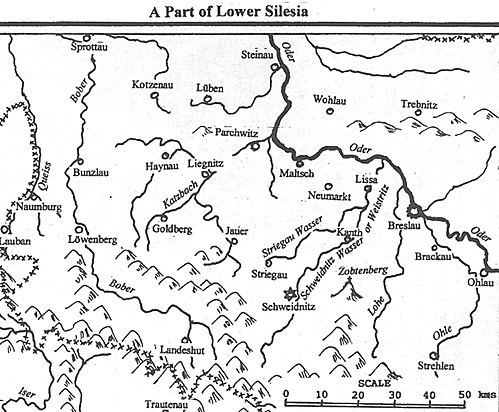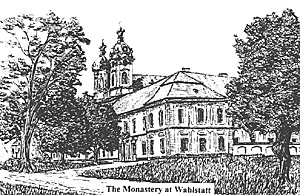 With increasing evidence that the King is now firmly occupied by the French and Empire armies in Saxony and with certain information of the success of the Russians in the East, the Austrians find that their goal of liberating Silesia is now open to them. Only the weak Prussian Corps of the Duke of Bevern and the garrisons of Schweidnitz and Breslau stand in their way.
With increasing evidence that the King is now firmly occupied by the French and Empire armies in Saxony and with certain information of the success of the Russians in the East, the Austrians find that their goal of liberating Silesia is now open to them. Only the weak Prussian Corps of the Duke of Bevern and the garrisons of Schweidnitz and Breslau stand in their way.
I would like to thank Ralph Morrison for his efforts in searching for sources of old German maps of Silesia for me. Lack of these had been a considerable embarrassment for determining the positions of small townships and villages. I finally managed to secure a set of photocopies of the relevant 1:100,000 scale circa 1938 topographical maps from the library of the University of Cambridge. These, combined with the modern 1:100,000 scale topographical maps entitled "Jeleniogorskie" and "Legnickie" published by Przedsiebiorsto Geodezy Jno-Kartograficzne Katowice (ISBN 83-86350-09-1 & 83-86350-10-5) have allowed me to follow the operations from the sketches of the camps recorded by St Paul.
The ground between Hohendorf and Schlaup (Plate 51) would subsequently become famous for the Battle of the Katzbach (26 August 1813), when Macdonald and Sebastini suffered some discomfort at the hands of Langeron and Sacken. Participants in the Duffy Tour of Silesia may recall trying to cross from the North bank of the Katzbach near Riemberg and finding that the bridge had been swept away in a recent flood. To camp in front of such a treacherous river possibly demonstrates the confidence of the Austrian High Command. If my memory serves me right, we crossed the Katzbach at Goldberg before following the route of the Austrian march South East to Jauer (Plate 52). We then turned North to Wahlstatt (Plate 53), where we paused to visit the museum dedicated to the battle in 1241 between Duke Henry II "the Pious" of Silesia and the Mongol horde of Kaidu.
 Although Duke Henry was slain and his army defeated, the victorious Mongols advanced no further into Central Europe; indeed they subsequently retired from the field. St Hedwy, the mother of Henry, erected a chapel near where her son died. Around that chapel the monastery (Plate 54) grew up. From Wahlstatt, we went on to Liegnitz before heading back to Breslau.
Although Duke Henry was slain and his army defeated, the victorious Mongols advanced no further into Central Europe; indeed they subsequently retired from the field. St Hedwy, the mother of Henry, erected a chapel near where her son died. Around that chapel the monastery (Plate 54) grew up. From Wahlstatt, we went on to Liegnitz before heading back to Breslau.
Just possibly, some of you may have photographs from that day - Wednesday 20th May 1998 - of the ground between Hohendorf and Liegnitz in your collections. I would be very pleased to have copies of any photographs that you feel might illustrate the terrain especially for the ground between Wahlstatt and Liegnitz, of which the importance will later become apparent.
Journal of Horace St. Paul 1757 Part 6
-
Introduction
September 14, 1757
September 15, 1757
September 16, 1757
September 17, 1757
September 18, 1757
September 19, 1757
September 20, 1757
September 21, 1757
September 22, 1757
September 23, 1757
More Journal of Horace St. Paul 1757
-
Part 1: Introduction (June 30-July 14)
Part 2: Introduction (July 15-July 25)
Part 3: Introduction (July 26-August 19)
Part 4: August 20-September 7)
Part 4: September 7-September 13)
Back to Seven Years War Asso. Journal Vol. XII No. 3 Table of Contents
Back to Seven Years War Asso. Journal List of Issues
Back to Master Magazine List
© Copyright 2001 by James J. Mitchell
This article appears in MagWeb (Magazine Web) on the Internet World Wide Web.
Other articles from military history and related magazines are available at http://www.magweb.com